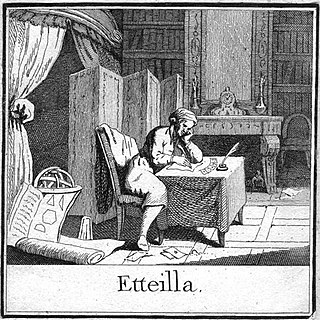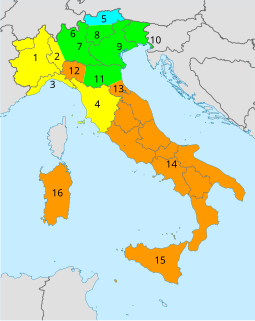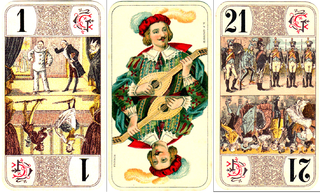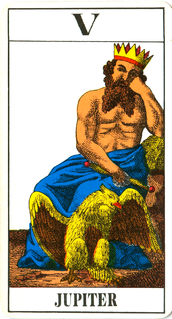Related Research Articles

The tarot is a pack of playing cards, used from the mid-15th century in various parts of Europe to play games such as Italian tarocchini, French tarot and Austrian Königrufen, many of which are still played today. In the late 18th century, some tarot decks began to be used for divination via tarot card reading and cartomancy leading to custom decks developed for such occult purposes.

Cartomancy is fortune-telling or divination using a deck of cards. Forms of cartomancy appeared soon after playing cards were first introduced into Europe in the 14th century. Practitioners of cartomancy are generally known as cartomancers, card readers, or simply readers.

The Minor Arcana, sometimes Lesser Arcana, are the suit cards in a tarot deck. Minor Arcana cards first appear in tarot card games, with pip cards numbered one (ace) to ten, along with court cards in each of four suits. In contemporary tarot decks the Minor Arcana are often illustrated—a convention popularized by the Rider-Waite tarot deck in 1910. Used in a tarot card reading in conjunction with the Major Arcana, the cards of the Minor Arcana suggest subtleties and details and signify day-to-day insights.

In occult practices, the Major Arcana are the trump cards of a tarot pack. There are usually 22 such cards in a standard 78-card pack. They are typically numbered from 0 to 21.
The Rider-Waite tarot deck, originally published during 1909, is widely considered the most popular tarot deck for tarot card reading. Other names for this deck include the Waite-Smith, Rider-Waite-Smith, or Rider tarot deck. The cards were drawn by illustrator Pamela Colman Smith from the instructions of academic and mystic A. E. Waite and were originally published by the Rider Company. The deck has been published in numerous editions and inspired a wide array of variants and imitations. It is estimated that more than 100 million copies of the deck have been published in more than 20 countries.

The Magician (I), also known as The Magus or The Juggler, is the first trump or Major Arcana card in most traditional Tarot decks. It is used in game playing and divination; in the English-speaking world, the divination meaning is much better-known.

The High Priestess (II) is the second trump or Major Arcana card in most traditional Tarot decks. This card is used in game playing as well as in divination. In the first Tarot pack with inscriptions, the 18th-century woodcut Marseilles Tarot, this figure is crowned with the Papal tiara and labelled La Papesse, the Popess, a possible reference to the legend of Pope Joan.

"Etteilla", the pseudonym of Jean-Baptiste Alliette, was the French occultist who was the first to popularise tarot divination to a wide audience (1785), and therefore the first professional tarot occultist known to history who made his living by card divination. Etteilla published his ideas of the correspondences between the tarot, astrology, and the four classical elements and four humors, and was the first to issue a revised tarot deck specifically designed for occult purposes (1791).

Playing cards have been in Italy since the late 14th century. Until the mid 19th century, Italy was composed of many smaller independent states which led to the development of various regional patterns of playing cards; "Italian suited cards" normally only refer to cards originating from northeastern Italy around the former Republic of Venice, which are largely confined to northern Italy, parts of Switzerland, Dalmatia and southern Montenegro. Other parts of Italy traditionally use traditional local variants of Spanish suits, French suits or German suits.

Strength is a Major Arcana Tarot card, and is numbered either XI or VIII, depending on the deck. Historically it was called Fortitude, and in the Thoth Tarot deck it is called Lust. This card is used in game playing as well as in divination.

The Tarot of Marseilles or Tarot of Marseille, also widely known by the French designation Tarot de Marseille, is one of the standard patterns for the design of tarot cards. It is a pattern from which many subsequent tarot decks derive.

The Visconti-Sforza tarot is used collectively to refer to incomplete sets of approximately 15 decks from the middle of the 15th century, now located in various museums, libraries, and private collections around the world. No complete deck has survived; rather, some collections boast a few face cards, while some consist of a single card. They are the oldest surviving tarot cards and date back to a period when tarot was still called Trionfi cards, and used for everyday playing. They were commissioned by Filippo Maria Visconti, Duke of Milan, and by his successor and son-in-law Francesco Sforza. They had a significant impact on the visual composition, card numbering and interpretation of modern decks.

Six of wands or batons is a card used in Latin-suited playing cards, which include tarot decks. It is part of what tarot card readers call the "Minor Arcana," the six of wands cards in divination decks with illustrated pip cards, displays a laureled horseman bearing a staff adorned with laurel crown. Footmen with staves are at his side.

Tarot card reading is a form of cartomancy whereby practitioners use tarot cards purportedly to gain insight into the past, present or future. They formulate a question, then draw cards interpret them for this end. A regular tarot deck consists of 78 cards, which can be split into two groups, the major arcana and minor arcana.

The Tarot Nouveau, French Tarot Nouveau or Bourgeois Tarot deck is a pattern of tarot cards of German origin that is still used for playing card games today in western Europe and Canada. It is not used for divinatory purposes, for which tarot cards are most commonly known outside continental Europe. This deck is most commonly found in France, Belgian Wallonia, Swiss Romandy and Canadian Québec for playing French Tarot; in southwest Germany for playing Cego and Dreierles; and in Denmark for Danish Tarok. The name preferred by the International Playing Card Society for this pattern is Bourgeios Tarot.

The Swiss 1JJ Tarot deck is a 78-card deck used for the tarot card games Troccas and Troggu and also for divination.

Tarot games are card games played with tarot decks, that is, decks with numbered permanent trumps parallel to the suit cards. The games and decks which English-speakers call by the French name Tarot are called Tarocchi in the original Italian, Tarock in German and various similar words in other languages. The basic rules first appeared in the manuscript of Martiano da Tortona, written before 1425. The games are known in many variations, mostly cultural and regional.

French-suited playing cards or French-suited cards are cards that use the French suits of trèfles, carreaux, cœurs, and piques. Each suit contains three face cards: the valet, the dame, and the roi (king). Aside from these aspects, decks can include a wide variety of regional and national patterns, which often have different deck sizes. In comparison to Spanish, Italian, German, and Swiss playing cards, French cards are the most widespread due to the geopolitical, commercial, and cultural influence of France, the United Kingdom, and the United States in the 19th and 20th centuries. Other reasons for their popularity were the simplicity of the suit insignia, which simplifies mass production, and the popularity of whist and contract bridge. The English pattern of French-suited cards is so widespread that it is often also known as the International or Anglo-American pattern.

The Fool is one of the 78 cards in a tarot deck. In tarot card reading, it is one of the 22 Major Arcana, sometimes numbered as 0 or XXII. However, in decks designed for playing traditional tarot card games, it is typically unnumbered, as it is not one of the 21 trump cards and instead serves a unique purpose by itself.
U.S. Games Systems (USGS) is a publisher of playing cards, tarot cards, and games located in Stamford, Connecticut. Founded in 1968 by Stuart R. Kaplan, it has published hundreds of different card sets, and about 20 new titles are released annually. The company's product line includes children's card games, museum products, educational cards, motivational cards, tarot cards, and other fortune telling card decks. These are marketed through a network of retailers, including bookstores, museum gift shops, metaphysical shops, greeting card stores; toy and game stores; hobby shops, and mail order catalogs.